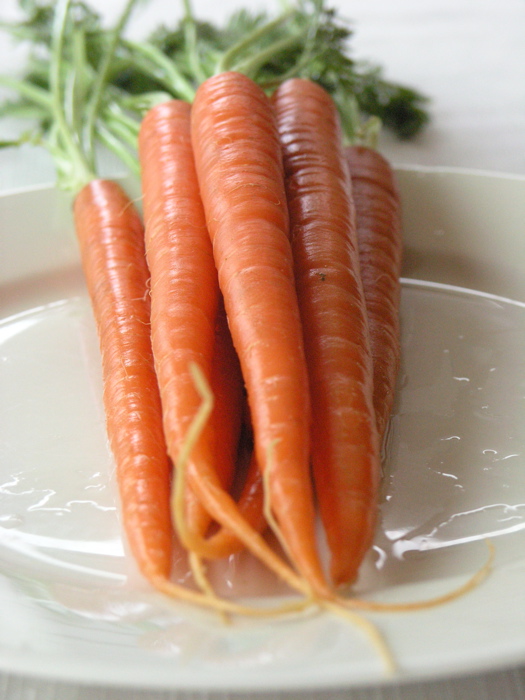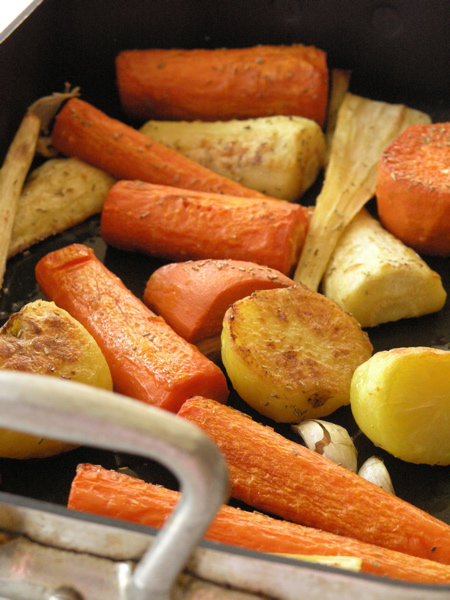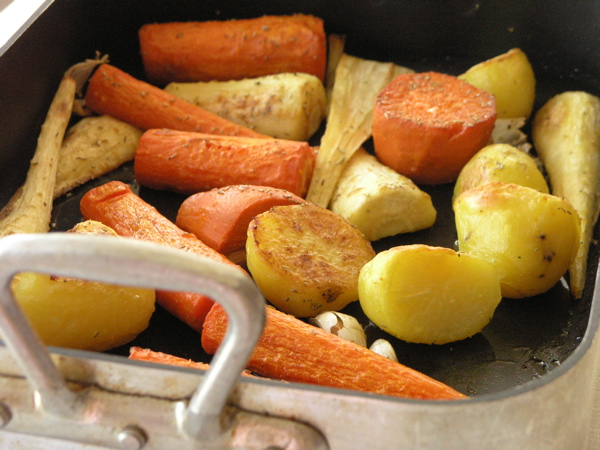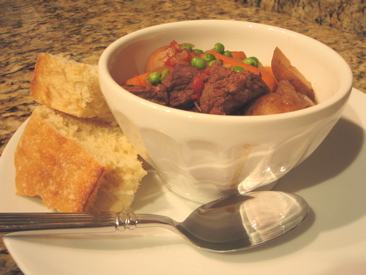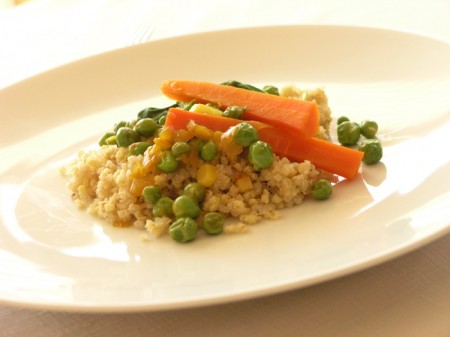
It’s day five of my blogging event: “How to host an elegant, flavorful, vegan, gluten-free dinner party” in which I feature recipes created by the wonderful Viviane Bauquet Farre of food and style. My husband and several of his friends have transitioned to a vegetarian diet and several of them are also avoiding dairy and gluten, so when I decided to celebrate G’s birthday with a dinner party, I knew I needed to turn to my friend Viviane who features such refined recipes which also happen to be meat free. Today’s installment is the fourth of that five-course meal – the main course, in fact. For dessert, you’ll just have to check back tomorrow.
For this course, I got to experiment with fresh vegetables from the farmer’s market I’ve been dying to use, like English peas and fava beans. If you’re going to choose between the two, English peas are way easier to prepare. You just have to pop the peas out of the pod and they’re ready to go. Fava beans, on the other hand, require several steps. The beans within the pods are coated with a little jacket that needs to be removed as well. For this recipe, I actually prepared both and it took all day. Luckily, I was able to stream three episodes of This American Life while I shucked, blanched and peeled.
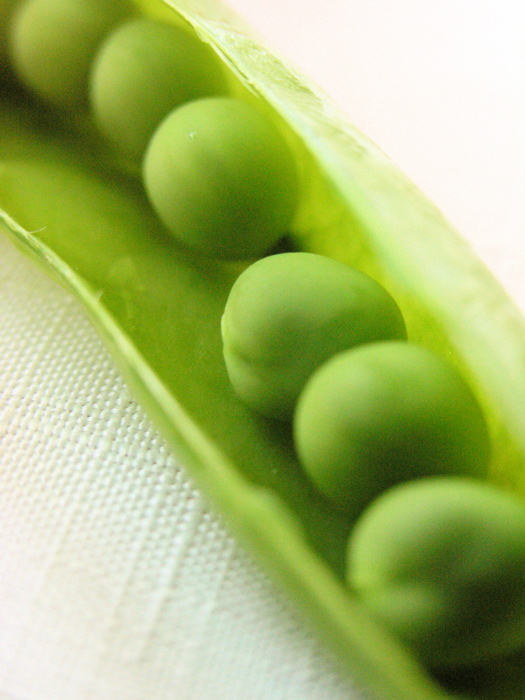
I prepared the fava beans by following the first part of a recipe by LocalLemons. First I had to remove the beans from their pods. Rinse them. Blanch them for 30 seconds and then pull off the outer layer from each bean. The inner bean is bright green and more fragile. After 3 hours of work, I forgot to photograph the bright green inner beans, but you can see what they look like over at the LocalLemons post. Here’s what they look like during step one and two.
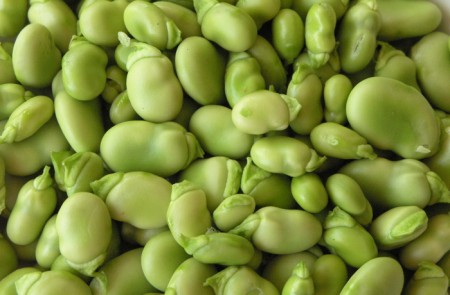
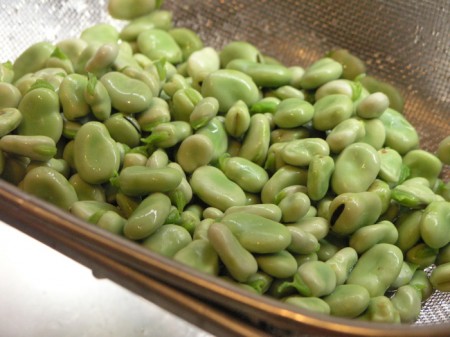
This dish is truly scrumptious. It is lighter than risotto because there is no butter and no Parmesan cheese, but the saffron, wine and garlic more than make up for flavor. I would make this dish again in a minute and look forward to varying the vegetables depending on what’s in season.

Saffron and White Wine Braised Spring Vegetables
Adapted from a recipe by Viviane Bauquet Farre, with permission
Served over Quinoa-Millet Pilaf (version also included below)
serves 4
For the vegetables
1/4 cup extra virgin olive oil
2 large shallots – skinned, quartered and finely sliced
1 teaspoon saffron threads – gently pounded in a mortar to a coarse powder
1 1/2 cups dry white wine
2 garlic cloves – skinned and finely chopped
2 medium, young carrots – peeled and cut in 1/8″ x 1″ sticks
4 oz shelled fresh English peas
8 oz asparagus – stalk ends snapped off and spears cut on the diagonal in 1″ pieces
1/2 teaspoon sea salt
freshly ground black pepper to taste
A handful of fresh baby arugula
For the quinoa-millet pilaf
1 Tbsp extra virgin olive oil
1-2 shallots, diced finely
1 clove of garlic, peeled and bashed
½ cup millet
½ cup quinoa (rinsed well)
2 ½ cups vegetable stock
Sea salt to taste (about 1/2 tsp)
About a cup of shelled fava beans
Method
1. To get the quinoa-millet pilaf started, put the quinoa in a fine-mesh strainer and place a bowl underneath. Rinse with cold water while rubbing the quinoa between your fingers. The water will become cloudy. Drain, and repeat this process with fresh water two more times. Strain excess water and set aside. Heat the olive oil in a saucepan over medium heat. Add the shallots and sauté for about 4 minutes, or until soft. Add the garlic and sautée for another minute. Now we are going to toast the grains so that they have a rich, nutty flavor. Add the millet, and sauté for 5 minutes, stirring frequently. Now add the quinoa and sauté for 2 to 3 minutes more. Again, stirring frequently to coat the grains with the olive oil, shallots and garlic. Add the vegetable stock and salt and bring to a boil. Reduce heat, simmer, covered for about 30 minutes, or until the water is absorbed. Fluff before serving
2. Now that the quinoa-millet is cooking, it’s time to do the vegetables. Heat the olive oil in a wide, heavy-bottomed skillet over medium-high heat. Add the shallots and sauté for 1 to 2 minutes until they have softened. Add the wine, saffron, and garlic. Bring to a full boil and then reduce heat to between medium and medium-low. Cover the pan and simmer for 5 minutes. Add the carrots, toss well, cover the pan and simmer for 10 minutes. During my dinner party, I actually paused the dish here while we were eating and the carrots steeped in the saffron-wine-garlic sauce (with no heat) for about 20 minutes. This had the delightful effect of infusing them with intense saffron flavor. You could try it that way.
3. Add the peas and asparagus, toss well, cover the pan and continue to simmer for 5 minutes until the asparagus are tender but still a bit crunchy. Uncover the pan. Raise heat to high, add the salt, black pepper to taste and the arugula. Toss until the arugula has wilted, about 30 seconds to 1 minute. Immediately remove from heat.
4. To serve, spoon the pilaf into shallow bowls. Top with the braised vegetables. Drizzle with the pan juices. Garnish with a drizzle of olive oil. Serve immediately.
Optional fava bean addition:
Sautée the fava beans over medium high heat in a separate sautée pan, with some olive oil and pepper for about 3 minutes. Serve as a garnish on top.
